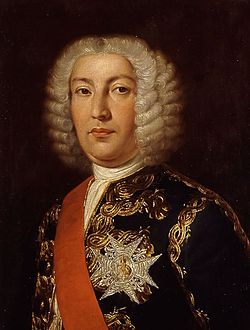- Juan José Navarro, 1st Marquis of la Victoria
-
José Navarro 
Portrait of José Navarro, Museo Naval de Madrid.Born November 30, 1687
Messina, ItalyDied February 5, 1772
Cadiz, SpainAllegiance  Spain
SpainService/branch Spanish Navy Rank Admiral Battles/wars War of the Spanish Succession
War of the Quadruple Alliance
War of the Austrian SuccessionAwards Marquis of Victory Juan José de Navarro Viana y Búfalo (Messina, November 30, 1687 – Isla de León Cadiz, February 5, 1772) was a Spanish military officer, Marqués de la Victoria and first Captain General of the Spanish Navy.
He was the son of Ignacio de Navarro, a Spanish Army captain and Livia Búfalo, a Sicilian noblewoman.
He entered the Spanish Army at the age of eight and fought in the War of Spanish Succession in Italy. In 1708 he fought the Moors in Oran, where his brother Ramón was killed and his father died in captivity. In 1709 he returned to Spain and fought in the Battle of Almenar and the Battle of Zaragoza, where he was made prisoner by the troops of Guido Starhemberg.
After the signing of the Peace of Utrecht, he became captain of his late father's company, and participated in the pacification of Catalonia.
After the war, he joined the Navy and at the outbreak of the War of the Quadruple Alliance, he sailed on the Real to Sardinia and Sicily with the Army under the Marquis of Lede, and took part in their conquest as part of the Spanish Navy Marines.
Navarro was also an important author of several books on military theory. Under protection of José Patiño, he rose through the ranks.
In 1732, he participated in the conquest of Oran under the Duke of Montemar and played an important role in covering the landing troops by the use of his naval guns.
In the War of Austrian Succession he won his greatest victory in beating a British fleet in the Battle of Toulon (1744). He was promoted to lieutenant general (Teniente Géneral) and received the title of marqués de la Victoria (marquis of Victory).
After the battle his fleet remained locked up in Cartagena, by a fleet of 21 ships under Rear-Admiral William Rowley.
On March 15, 1750 he became Director General of the Armada.
Six years later he finished his Diccionario demostrativo de la configuración y anatomía de toda arquitectura naval moderna. He had entered the Real Academia Española in 1740.
In 1759, he commanded the convoy of 36 ships that brought Charles III, the new King of Spain, from Naples to Spain. His flagship was the El Fénix (80 guns) with his son-in-law Gutierre de Hevia as captain. For this save passage, he received a golden baton and was made Captain General of the Spanish Navy on December 13 of that year. The last assignment of the 80-year-old Marqués de la Victoria, was to organize a squadron of nine ships which escorted Infanta María Louisa to her husband Leopold II, Holy Roman Emperor, and brought back Maria Luisa of Parma, who was to marry Charles IV of Spain.
Navarro died of Gangrene at the age of 84.
Source
- This article incorporates information from the equivalent article on the Spanish Wikipedia.
Categories:- Spanish admirals
- Spanish nobility
- 1687 births
- 1772 deaths
- Spanish military personnel of the War of the Austrian Succession
- Deaths from gangrene
Wikimedia Foundation. 2010.
